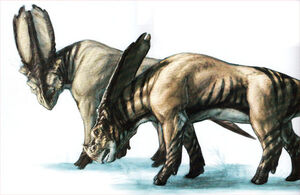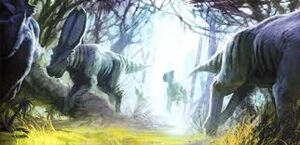
The Tree-Tops, (Sylvaceratops) is a swift, jungle-dwelling ceratopsoid from Skull Island. It measures 12-16 feet long.
Facts[]
Deep in the steamy jungle, a bizarre member of the ceratopsian suborder has adapted to life amid the tangled trunks. Where the lowland plains’ bulky Ferrucutus bares the build of a heavyweight boxer, the graceful tree-tops has a dancer’s physique. Tall and lithe, they are narrow through the body to allow them to slip easily through the dense maze of trunks, their long frills lying flat along their necks as they press through thick vegetation.
When threatened, tree-tops will rely on speed and agility to escape. Only during the nesting season will bulls and cows stand their ground, lowering their shield-like faces to the ground to form a wall of bone and horn between their vulnerable eggs and would-be predators like Venatosaurus, Omnimatercimex and Foetodon.

Like Ferrucutus, tree-tops travel in small familial herds. Males compete for access to females but become territorial only during the breeding season, permitting several other adult males to coexist in harmony within the same herd for most of the year.
Adult males’ frills become elaborately colored during the breeding season, with the most brilliant attracting a large harem of females. Small occipital horns also sprout seasonally and are used in jousting fights between the bulls to assert dominance. The curving brow horns allow the competing bulls to grapple, the winner bringing an opponent to the ground in contests that are as much of balance as of brute strength. Occipital horns are shed later, minimizing the chance of snags or entanglement.
Tree-tops subsist on shrubs and undergrowth, supplementing their diet with seasonal fruit and nuts fallen from the canopy. At certain times of the year the genus will demonstrate uncanny intuition, waiting below a particular tree the very day the fruit begins to fall.
If they fall into the abyssal chasms, tree-tops can be prey to things like Decarnocimex.
Skeletal Adaptations[]
Long legs give tree-tops excellent speed and agility. With three strong toes on each foot, which bare resemblance to mammalian hooves, these rather beautiful genasaurs have excellent grip and balance. The nimble tree-tops can jink and spring to avoid attack, cutting a zigzagging trail through the dense trees and vines that few predators can match.
Relationship with the Carver[]
Most small to midsized herbivorous inhabitants of the jungle are potential Carver prey, but they commonly take young tree-tops. The agile ceratopsians are faster through the dense jungle, so the almost felid-like Carvers take advantage of overhanging boughs or fallen trees to approach hidden from above, remaining concealed until within pouncing range.
